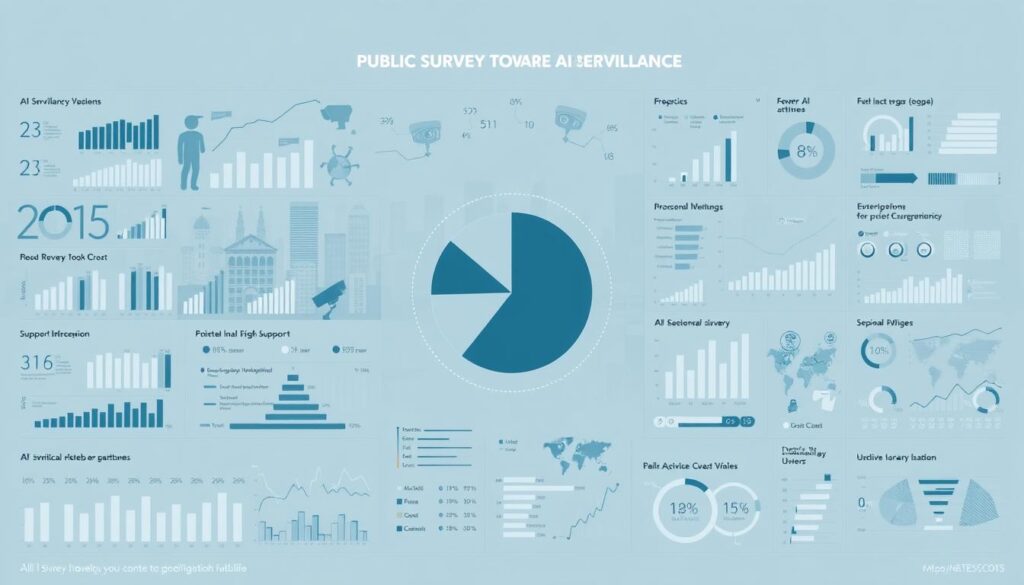Did you know that over 1 billion surveillance cameras are estimated to be active worldwide by 2023, with a significant portion powered by artificial intelligence? This staggering figure highlights the pressing need for a thorough examination of AI surveillance ethics. As AI technologies evolve, they integrate into our daily lives, presenting both opportunities and challenges. Understanding ethical frameworks, responsible AI development, and civil liberties has never been more critical.
AI surveillance includes a wide range of technologies, from facial recognition systems in public areas to algorithm-driven monitoring in workplaces. These innovations promise enhanced security and operational efficiency. Yet, they also raise significant ethical dilemmas. How do we balance the benefits of AI surveillance with the potential invasions of privacy and infringement on human rights?
This article aims to explore the complex ethical landscape of AI surveillance. You will gain insights into the technology, its applications, and the ethical concerns it raises. By grasping the principles of responsible AI development and the importance of protecting civil liberties, you will be better equipped to navigate the intricate balance between security and privacy.
Learn more about the ethical implications of AI and understand how these technologies might impact your daily life.
Key Takeaways
- The global proliferation of AI-powered surveillance cameras highlights the pressing need for ethical scrutiny.
- AI surveillance technologies are used in various domains, including public safety and corporate environments.
- Balancing the benefits of AI surveillance with privacy and civil liberties is a critical challenge.
- Ethical frameworks and responsible AI development are essential for protecting human rights.
- Public awareness and engagement are key to ensuring transparency and accountability in AI surveillance.
Understanding AI Surveillance
AI Surveillance has seen a remarkable surge in recent years, reshaping numerous sectors with cutting-edge technologies like facial recognition and data analytics. This section will offer a detailed grasp of its definition, scope, and pivotal technologies.
Definition and Scope
AI Surveillance leverages artificial intelligence to monitor, track, and collect data on individuals or groups. It permeates both public and private domains, affecting sectors such as national security, law enforcement, and corporate surveillance. The advent of more sophisticated AI systems escalates the intricacies and importance of privacy concerns and data protection.
Key Technologies in AI Surveillance
The fundamental technologies in AI Surveillance encompass:
- Facial Recognition Technology: This employs AI algorithms to pinpoint individuals through facial characteristics. It is prevalent in security systems, airports, and social media platforms.
- Gait Analysis: AI can identify individuals by analyzing their gait. This technology is employed when facial recognition is ineffective, such as in low-light conditions.
- Predictive Policing: AI systems scrutinize data to forecast crime hotspots and potential perpetrators. This strategy aims to bolster public safety but also stirs intense privacy concerns.
Grasping these technologies is crucial for understanding their broad applications and the burgeoning ethical discussions surrounding data protection and individual privacy. As you continue to explore, reflect on how these tools influence our everyday lives and policy formulations.
The Growing Use of AI Surveillance in Society
In recent years, AI surveillance has seen a significant rise, permeating various sectors and sparking critical discussions on human rights and algorithmic bias. This section delves into the widespread adoption of AI surveillance in both government and corporate realms. It also examines its profound effects on public safety.
Government Applications
Governments worldwide have embraced AI surveillance to bolster national security and law enforcement efforts. These systems, aimed at predicting and preventing threats, rely on intricate algorithms. Yet, the hurdles in ensuring transparency and accountability are substantial. This is notably true when AI-driven decisions can have profound impacts on individuals’ lives.
Corporate Surveillance Practices
Corporations employ AI surveillance for diverse objectives, including monitoring employee activities and analyzing consumer behavior. These endeavors can enhance operational efficiency and security. Yet, they also ignite debates on privacy and data ethics. It is imperative to strike a balance between operational efficiency and human rights to uphold trust and ensure technology’s positive impact.
Impact on Public Safety
The implementation of AI surveillance in public areas aims to bolster safety and security by swiftly identifying and addressing risks. Despite this, worries about algorithmic bias in AI systems raise concerns about unequal treatment of various communities. This could undermine the purpose of these technologies. Developing robust frameworks for transparency and accountability is essential to build public trust and ensure these systems operate equitably for all.
Ethical Concerns Surrounding AI Surveillance
As AI surveillance technologies proliferate, several ethical concerns arise to protect your civil liberties. These include the invasion of privacy, data ownership, and the risk of algorithmic bias. These issues are critical to address to ensure a fair and just technological environment.
Privacy Invasion
Privacy invasion is a primary ethical concern with AI surveillance. Advanced AI systems can monitor and analyze personal behaviors in unprecedented ways. For instance, Amazon’s Ring doorbell cameras and law enforcement’s use of facial recognition technologies underscore the need for a balance between security and privacy. To safeguard your civil liberties, it is crucial to establish clear boundaries for AI surveillance, preventing unwarranted intrusion into personal lives.
Data Ownership
Data ownership is another critical aspect. AI surveillance systems collect and process vast amounts of data, raising questions about ownership. The debate revolves around how data is used, shared, and protected. To ensure robust data protection, it is essential to establish clear regulations defining individual data ownership rights. This will safeguard your rights and freedoms.
The Risk of Bias
Algorithmic bias is a pressing ethical issue in AI surveillance. Bias in algorithms can disproportionately affect marginalized communities, exacerbating existing inequalities. For example, a study by MIT Media Lab revealed facial recognition technologies were less accurate for women and people of color. This highlights concerns about fairness and discrimination. By focusing on ethical deployment, developers can mitigate such biases, ensuring AI applications promote fairness.
Addressing these ethical concerns necessitates a collective effort from legal frameworks, corporate practices, and societal engagement. Integrating data protection and civil liberties into AI development is vital for a balanced and fair technological future.
Legal Frameworks Governing AI Surveillance
The advent of AI surveillance technologies necessitates the establishment of stringent legal frameworks. It is imperative to comprehend the existing regulations and proposed legislation. This understanding is vital for ensuring that surveillance practices are conducted ethically and with due responsibility.
Current Regulations
Regulations surrounding AI surveillance exhibit considerable variability across different jurisdictions. In the United States, the General Data Protection Regulation (GDPR) serves as a guiding principle for AI usage, emphasizing Data Protection and user consent. The California Consumer Privacy Act (CCPA) also addresses the ethical deployment of Facial Recognition Technology in both public and private domains.
Proposed Legislation
Legislators are actively crafting new bills aimed at bolstering data protection and integrating Ethical Frameworks into AI technologies. The proposed Algorithmic Accountability Act seeks to mandate accountability for companies’ algorithms, tackling potential biases and ensuring transparency. This initiative has ignited a heated debate, highlighting the necessity for a unified legal standard.
International Standards
Internationally, standards established by entities like the International Organization for Standardization (ISO) serve as a model for ethical AI surveillance governance. These standards underscore the significance of Ethical Frameworks, striving to harmonize innovation with Data Protection and human rights. Countries in Europe, Asia, and other regions are increasingly embracing these guidelines to foster global uniformity.
The creation and enforcement of these regulations and standards are of paramount importance. As AI progresses, staying abreast of current and forthcoming legal frameworks is essential. This knowledge will enable you to navigate the intricate realm of AI surveillance with responsibility.
Balancing Security and Privacy
In today’s world, where security threats are becoming more complex, finding a balance between security and privacy is crucial. This balance is essential to protect your privacy while utilizing cutting-edge technologies for safety.
The Role of Transparency
Transparency is key in building trust between the public and organizations using AI surveillance. Clear and accessible information about surveillance technology usage is vital. It allows stakeholders to create an environment of accountability. Transparent practices alleviate privacy concerns and demonstrate a commitment to ethical AI development.
Ethical AI Design
Responsible AI development starts with ethical AI design. This means creating systems that prioritize privacy and security. By developing AI with these principles in mind, we can maintain a balance between security enhancement and privacy respect. Adhering to ethical standards is vital for safeguarding rights and preventing misuse.
Public Awareness and Engagement
Public awareness and engagement are critical in the AI surveillance debate. Educating the public about surveillance technologies and their effects is essential. It fosters informed discussions and participation. Increased engagement brings diverse perspectives, leading to more balanced and inclusive strategies.
Public Perception of AI Surveillance

Understanding public perception of AI surveillance is crucial for balancing its benefits with fundamental principles of Human Rights and Civil Liberties. Recent polling data and trend analyses offer insights into societal attitudes toward AI surveillance technologies.
Polling Data and Trends
Studies indicate a complex and often polarized view of AI surveillance. According to recent surveys, a significant segment of the population is concerned about potential infringements on Human Rights and Civil Liberties. On the other hand, a substantial portion supports its deployment, citing the enhancement of Public Safety as a primary benefit. These divergent views highlight the need for a nuanced approach to AI surveillance policy.
Case Studies on Public Response
Examining case studies on AI surveillance’s implementation reveals varied community responses. For instance, areas with higher crime rates often show greater acceptance of increased monitoring due to perceived improvements in Public Safety. Yet, other communities have raised concerns, emphasizing Human Rights and Civil Liberties breaches. This is notably where transparency and accountability are lacking.
Consequences of Unchecked AI Surveillance
The repercussions of unchecked AI surveillance extend far beyond mere technological progress. The risk of abuse is a primary concern, yet the broader societal impacts demand equal scrutiny. Human rights organizations have sounded the alarm about the decline of civil liberties due to pervasive surveillance.
Potential for Abuse
AI surveillance, unchecked, poses a significant threat to both governmental and private misuse. History has shown that surveillance tools can be used to stifle dissent, target minority groups, and exacerbate social disparities. The inherent algorithmic bias in many AI systems escalates these risks, fostering an environment where unjust actions become normalized.
Long-term Societal Impacts
The long-term societal effects of unchecked surveillance are far-reaching. Sociologists foresee a future where privacy concerns fundamentally alter interactions with technology and among individuals. Widespread surveillance could foster a society characterized by self-censorship, undermining community trust. Without adequate oversight, the erosion of civil liberties could become a hallmark of contemporary life, with enduring impacts on democratic principles.
The Role of Technology Companies

As technology companies advance in AI surveillance tool development, they must embrace responsible AI development. They have the capability to mold the surveillance future, ensuring privacy and civil liberties are respected.
Responsibilities of AI Developers
AI developers must follow detailed ethical frameworks to guarantee their innovations benefit society. Their duties encompass:
- Data Protection: Ensuring user data is secure, preventing unauthorized access and misuse.
- Implementing privacy-by-design principles in AI systems to reduce privacy risks.
- Regularly assessing and mitigating bias in AI models to foster fairness and equity.
Transparency and Accountability
For AI surveillance to earn public trust, companies must focus on transparency and accountability. This entails:
- Issuing regular reports on the ethical considerations and impacts of their AI tools, similar to corporate social responsibility reports.
- Adopting industry guidelines and best practices for transparency.
- Creating open channels for public feedback and independent audits to ensure accountability.
By adhering to strong ethical frameworks and prioritizing responsible AI development, technology companies can lay a solid foundation for AI surveillance technologies. These technologies will protect user data and uphold societal values.
Future Trends in AI Surveillance Ethics
As AI surveillance evolves, it’s crucial to monitor how future trends will shape ethical compliance. Legislative, societal, and technological advancements will profoundly impact this path. The integration of ethical guidelines into Facial Recognition Technology advancements is a key aspect to consider.
Innovations in Ethical Compliance
Recent years have seen a surge in efforts to reduce Algorithmic Bias. These innovations are essential for ensuring AI systems operate fairly, avoiding the perpetuation of societal inequities. New methods for detecting and mitigating biases in Facial Recognition Technology are being developed, aiming for a more equitable AI landscape.
Data Protection has become a critical concern. The establishment of robust frameworks for secure data handling and storage is vital for maintaining ethical standards. As new technologies arise, the need to protect personal information grows exponentially.
Emerging Technologies and Their Implications
The implications of emerging technologies in AI surveillance are vast. Innovations like real-time data analysis and advanced Facial Recognition Technology provide unparalleled monitoring and security capabilities. Yet, it’s imperative to ensure these technologies align with ethical standards to prevent misuse.
Addressing Algorithmic Bias remains a pressing issue. Future trends suggest a significant investment in developing transparent and unbiased algorithms, fostering fairness across applications. Continuous enhancements in Data Protection measures will also be crucial for maintaining public trust and compliance with evolving regulations.
Recommendations for Responsible AI Surveillance
As AI surveillance advances, a clear roadmap for its responsible use is imperative. We present best practices and ethical standards, based on expert advice and proven models.
Best Practices for Implementation
Effective AI surveillance implementation hinges on several key practices. These emphasize Ethical Frameworks and Data Protection.
- Maintain ethical integrity: Establish Ethical Frameworks that steer AI technology development and deployment. These frameworks must uphold individual rights and societal values.
- Ensure Transparency and Accountability: Companies should pledge to Transparency and Accountability. This involves providing detailed insights into data collection and usage.
- Develop robust data protection measures: Implement thorough Data Protection protocols. These are essential to protect personal data and prevent unauthorized access.
- Foster public engagement: Engage with community stakeholders to address concerns and build trust.
- Regular audits and assessments: Perform regular audits and assessments. This ensures adherence to ethical standards and necessitates adjustments when needed.
Creating Ethical Guidelines
Establishing comprehensive ethical guidelines is vital for AI surveillance governance. These guidelines must encapsulate principles like fairness, accountability, and transparency.
- Fairness: AI systems must be designed and operated without bias. This ensures equal treatment for all individuals.
- Accountability: Organizations must be accountable for the ethical implications of their AI surveillance technologies.
- Transparency: Maintain openness about AI systems’ functionalities and decision-making processes. This ensures public awareness and comprehension.
- Privacy: Enforce stringent Data Protection policies. These are crucial to protect individual privacy and maintain public trust.
By integrating these best practices and ethical guidelines, organizations can develop responsible AI surveillance systems. These systems will balance innovation with societal values, ensuring Transparency and Accountability.
Conclusion: Navigating the Ethics of AI Surveillance
The convergence of AI surveillance, responsible AI development, and civil liberties poses a complex challenge. Stakeholders, including policymakers, technology developers, and the public, must navigate this evolving terrain. It is crucial to distill key takeaways to guide future actions. Understanding privacy concerns and ethical implications is essential for a balanced approach.
Takeaways for Stakeholders
Policymakers must establish robust legal frameworks that address the benefits and risks of AI surveillance. These regulations should protect civil liberties while promoting transparency and accountability. Technology developers should prioritize ethical AI design, embedding fairness and privacy by default in their systems. Public awareness and engagement are also critical, ensuring citizens understand the use and impact of surveillance technologies in their lives.
By addressing these considerations, stakeholders can mitigate risks while maximizing benefits. This approach will help shape an AI-driven future that respects our collective values and civil liberties.
Moving Forward with Caution
A cautious approach is necessary as we move forward. The potential for abuse and long-term societal impacts demands a concerted effort across sectors. Experts stress the importance of ongoing dialogue and continuous refinement of ethical guidelines to navigate this rapidly advancing domain responsibly.
Prioritizing privacy concerns and maintaining a commitment to ethical practices will be pivotal. This will shape an AI-driven future that upholds our collective values and civil liberties.

